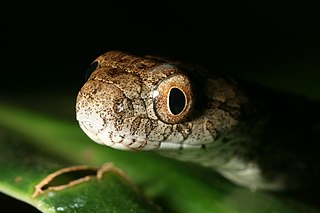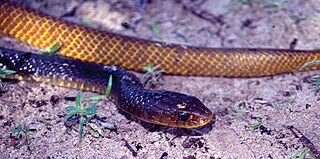
Amerotyphlops brongersmianus, known commonly as Brongersma's worm snake or the South American striped blindsnake, is a species of harmless blind snake in the family Typhlopidae. The species is native to South America and Trinidad and Tobago in the Caribbean. No subspecies are currently recognized.
Philodryas is a genus of colubrid snakes endemic to South America, commonly called green snakes.

Amphisbaena mertensii, also known as the Mertens' worm lizard or Mertens's worm lizard, is a species of worm lizard in the family Amphisbaenidae. The species is endemic to South America.

Liotyphlops ternetzii beui is a species of nonvenomous snake in the family Anomalepididae. The species is native to northeastern Argentina, eastern Paraguay, and central-western, southeastern, and southern Brazil; the Reptile Database restricts its range to Brazil. It is locally common in Brazil. It is sometimes known as the pale-headed blindsnake.

Apostolepis assimilis is a species of snake in the family Colubridae. It is found in central and southwestern Brazil, eastern Paraguay, Bolivia, and northern Argentina; the Reptile Database, however, does not mention Bolivia and treats Argentina as uncertain.

Thamnodynastes pallidus, the Amazon coastal house snake, is a species of snake in the family Colubridae. The species is endemic to South America.

Psomophis is a genus of snakes in the family Colubridae. The genus is endemic to South America.
Mussurana is a genus of snakes in the family Colubridae. The genus is endemic to South America.

Mussurana bicolor, the two-colored mussurana, is a species of snake in the family Colubridae. The species is native to southern South America.

Palusophis bifossatus is a species of snake of the family Colubridae.

The indigo snake, also known as the yellow-tail cribo, is a species of snake in the family Colubridae. This large colubrid snake is nonvenomous.
Simophis is a genus of snake in the family Colubridae that contains the sole species Simophis rhinostoma. It is commonly known as the São Paulo false coral snake.
Rhachidelus is a genus of snake in the subfamily Dipsadinae of the family Colubridae. The genus is endemic to South America.

Phimophis guerini, also known commonly as the Argentine pampas snake, is a species of snake in the subfamily Dipsadinae of the family Colubridae. The species is endemic to South America.
Apostolepis ambiniger, the Paraguayan blackhead, is a species of snake in the family Colubridae. It is found in Brazil, Bolivia, and Paraguay.
Apostolepis dimidiata, the common bilineate blackhead, is a species of snake in the family Colubridae. It is found in Brazil, Argentina, and Paraguay.
Apostolepis intermedia, Koslowsky's blackhead or Mato Grosso burrowing snake, is a species of snake in the family Colubridae. It is found in Brazil and Paraguay.

Psomophis joberti, also known commonly as Jobert's ground snake and cobra-corredeira in Brazilian Portuguese, is a species of snake in the subfamily Dipsadinae of the family Colubridae. The species is native to eastern South America.
Psomophis obtusus, also known commonly as the wide ground snake and corredeira-do-banhado in Brazilian Portuguese, is a species of snake in the subfamily Dipsadinae of the family Colubridae. The species is endemic to South America.
Xenodon histricus, Jan's hognose snake, is a species of snake in the family, Colubridae. It is found in Paraguay, Brazil, Argentina, and Uruguay.










